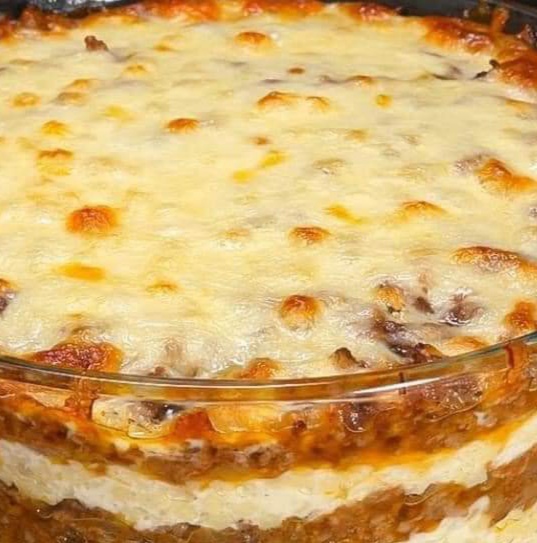Introduction
There’s something incredibly comforting about a homemade lasagna, with its layers of rich meat sauce, creamy cheese, and tender pasta. It’s a dish that brings people together, whether for a family dinner or a special occasion. This recipe promises to deliver a lasagna so delicious, you’ll never want to buy it from a store or restaurant again. With simple ingredients and easy-to-follow steps, you’ll create a lasagna that’s better than any you’ve tasted before.
The secret to this lasagna lies in its balance of flavors and textures. The savory meat sauce, the creamy ricotta mixture, and the gooey melted cheese all come together to create a dish that’s hearty, satisfying, and utterly irresistible. Whether you’re a seasoned cook or a beginner, this recipe will guide you through the process of making a lasagna that will impress everyone at the table.
Ingredients
For the meat sauce, you’ll need ground beef or Italian sausage, chopped onion, minced garlic, marinara sauce, crushed tomatoes, and a blend of seasonings like salt, pepper, and basil.
The cheese mixture combines ricotta cheese, egg, and a pinch of salt and pepper, while the layers are completed with shredded mozzarella and grated Parmesan cheese.
Lasagna noodles, either pre-cooked or no-boil, are the final essential component.
Instructions
Start by preparing the meat sauce. Brown the ground beef or sausage in a large skillet, then add the chopped onion and minced garlic. Once the onion is softened, stir in the marinara sauce, crushed tomatoes, and seasonings. Let the sauce simmer to develop its flavors. In a separate bowl, mix the ricotta cheese with an egg and a pinch of salt and pepper to create the creamy cheese layer.
Preheat your oven to the specified temperature and begin assembling the lasagna. Spread a thin layer of meat sauce in the bottom of your baking dish, followed by a layer of lasagna noodles. Add a portion of the ricotta mixture, then sprinkle with mozzarella and Parmesan cheese. Repeat the layers until all ingredients are used, finishing with a generous topping of cheese.
Cover the dish with aluminum foil and bake until the lasagna is heated through and the cheese is melted. Remove the foil and bake a little longer to achieve a golden, bubbly top. Let the lasagna rest before serving to allow the layers to set.
How to Make
Making lasagna is all about layering and patience. Begin by cooking the meat sauce, ensuring it’s rich and flavorful. The key is to let it simmer so the ingredients meld together. While the sauce cooks, prepare the cheese mixture, which adds a creamy, tangy element to the dish.
Assembling the lasagna is where the magic happens. Start with a thin layer of sauce to prevent sticking, then alternate between noodles, cheese mixture, and meat sauce. Don’t forget to sprinkle each layer with mozzarella and Parmesan for that perfect cheesy finish. The final layer should be a generous topping of cheese to create a golden, bubbly crust.
Baking the lasagna is the final step. Cover it with foil to keep it moist, then remove the foil near the end to let the cheese brown. Letting it rest after baking is crucial, as it allows the layers to set and makes slicing easier.
Variations
For a vegetarian twist, replace the meat sauce with a mixture of sautéed vegetables like zucchini, mushrooms, spinach, and bell peppers. You can also add a layer of roasted eggplant or butternut squash for extra depth of flavor. A vegetarian lasagna can be just as hearty and satisfying as the traditional version.
If you prefer a creamier lasagna, consider adding a béchamel sauce. This white sauce, made with butter, flour, and milk, can be used in place of or alongside the ricotta mixture. It adds a luxurious texture and pairs beautifully with the meat sauce and cheese.
For a lighter option, try using lean ground turkey or chicken instead of beef or sausage. You can also use low-fat ricotta and mozzarella cheese to reduce the calorie count without sacrificing flavor. Whole wheat or gluten-free lasagna noodles are great alternatives for those with dietary restrictions.
Tips
To ensure your lasagna turns out perfectly, use high-quality ingredients. Fresh herbs, freshly grated cheese, and a good marinara sauce can make a big difference in flavor. If you’re using no-boil noodles, make sure there’s enough sauce to keep them moist during baking.
When assembling the lasagna, don’t overfill the layers. Too much sauce or cheese can make the dish soggy. Aim for even layers to create a balanced texture. If you’re short on time, you can prepare the meat sauce and cheese mixture ahead of time and assemble the lasagna just before baking.
Letting the lasagna rest after baking is essential. This allows the layers to set and makes it easier to slice and serve. If you’re serving it for a special occasion, consider making it a day ahead. Lasagna often tastes even better the next day as the flavors have more time to meld.
How to Store
Leftover lasagna can be stored in an airtight container in the refrigerator for up to four days. To reheat, cover it with foil and bake in a preheated oven until warmed through. You can also freeze lasagna for up to three months. Wrap it tightly in plastic wrap and aluminum foil before freezing. Thaw it in the refrigerator overnight before reheating.
Conclusion
Homemade lasagna is a labor of love, but the results are well worth the effort. This recipe delivers a dish that’s rich, flavorful, and sure to impress. Whether you’re cooking for your family or hosting a dinner party, this lasagna will be the star of the meal.
With its layers of savory meat sauce, creamy cheese, and tender pasta, this lasagna is comfort food at its finest. Once you try this recipe, you’ll understand why it’s better than anything you can buy. So roll up your sleeves, gather your ingredients, and get ready to make the best lasagna of your life!
